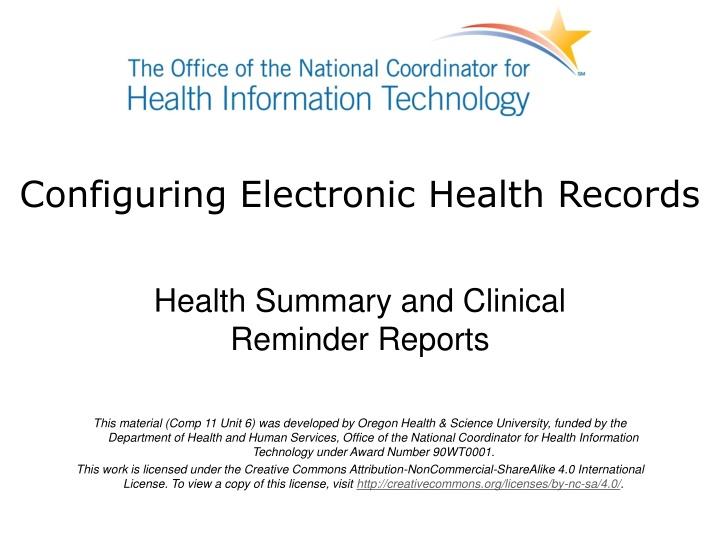
Enhancing Information Quality in Electronic Health Records
Learn about the dimensions of information quality, the importance of quality reporting in healthcare, and how health summary reports can improve care quality and efficiency.
Download Presentation

Please find below an Image/Link to download the presentation.
The content on the website is provided AS IS for your information and personal use only. It may not be sold, licensed, or shared on other websites without obtaining consent from the author. If you encounter any issues during the download, it is possible that the publisher has removed the file from their server.
You are allowed to download the files provided on this website for personal or commercial use, subject to the condition that they are used lawfully. All files are the property of their respective owners.
The content on the website is provided AS IS for your information and personal use only. It may not be sold, licensed, or shared on other websites without obtaining consent from the author.
E N D
Presentation Transcript
Configuring Electronic Health Records Health Summary and Clinical Reminder Reports This material (Comp 11 Unit 6) was developed by Oregon Health & Science University, funded by the Department of Health and Human Services, Office of the National Coordinator for Health Information Technology under Award Number 90WT0001. This work is licensed under the Creative Commons Attribution-NonCommercial-ShareAlike 4.0 International License. To view a copy of this license, visit http://creativecommons.org/licenses/by-nc-sa/4.0/.
Measuring Information Quality Data, information, knowledge and wisdom hierarchy Increase of complexity of understanding higher up the hierarchy Interrelationship between each level Each application requires careful analysis and consideration of multiple perspectives Overlapping influences provide impact on information quality 2
16 Dimensions of Information Quality - 1 Accessibility Appropriate amount of data Believability Completeness Concise representation Consistent representation 3
16 Dimensions of Information Quality - 2 Ease of manipulation Free-of-error Interpretability Objectivity Relevancy Reputation Security Timeliness Understandability Value-added 4
16 Dimensions of Information Quality - 3 There is no single set of metrics can be provide a summative evaluation of information quality Information quality results from on-going efforts to incorporate the underlying dimensions upon which information quality is assessed in all aspects of information collection, processing and dissemination Those efforts begin with an understanding of these dimensions of information quality 5
Quality Reporting Improves quality of care, patient safety and efficiency. Highlights collection of quality data. Provides efficiency and consistency through structured routine reports. Provides flexibility through ad hoc reporting. 6
Health Summary Reports Consists of two difference methods Ad hoc report for a specific patient or group of patients User-customized, clinical summary report Examine group of patients using specific set of criteria Can be viewed online or printed out 7
Clinical Reminders Helps in tracking procedures or activates that may be overlooked Reports allows users to large and small scale comparisons EHR makes reminders quick and easy Users can generate customized reminder reports 8
Health Summary and Clinical Reminder Reports Summary To design, view and create Health Summary reports To design, view and create Clinical Reminder reports How quality reporting supports quality care, patient safety, and efficiency The 16 dimensions of information quality 9
Health Summary and Clinical Reminder Reports References - 1 References Amatayakul MK. Electronic health records: A practical guide for professionals and organizations. 4th ed. Chicago IL: AHIMA; 2009. Calabrisi RR, Czarnecki T, Blank C. The impact of clinical reminders and alerts on health screenings. The VA Pittsburgh Healthcare System achieves notable results by enhancing an automated clinical reminder system within its CPR--and has the data to prove it. Health Manag Technol. 2002 Dec; 23(12):32-4. Carter JH. Electronic health records: A guide for clinicians and administrators. 2nd ed. Philadelphia: ACP Press; 2008. Eichenwald Maki S, Petterson B. Using the electronic health record. Canada: Delmar Cengage Learning; 2008. 10
Health Summary and Clinical Reminder Reports References - 2 References Eichenwald Maki S, Petterson B. Using the electronic health record. Canada: Delmar Cengage Learning; 2008. Hebda T, Czar P. Handbook of informatics for nurses & healthcare professionals. 4th ed. New Jersey: Pearson; 2009. Lehman HP, Abbot PA, Roderer NK, Rothschild A, Mandell SF, Ferrer JA, et al, editors. Aspects of electronic health record systems. U.SA: Springer; 2006. Pipino LL, Lee YW, Wang RY. Data quality assessment. Communications of the ACM. April 2002; 45(4ve):211-214. Available from: http://web.mit.edu/tdqm/www/tdqmpub/PipinoLeeWangCACMApr02.pdf. 11
Configuring Electronic Health Records Health Summary and Clinical Reminder Reports This material was developed by Oregon Health & Science University, funded by the Department of Health and Human Services, Office of the National Coordinator for Health Information Technology under Award Number 90WT0001. 12






















